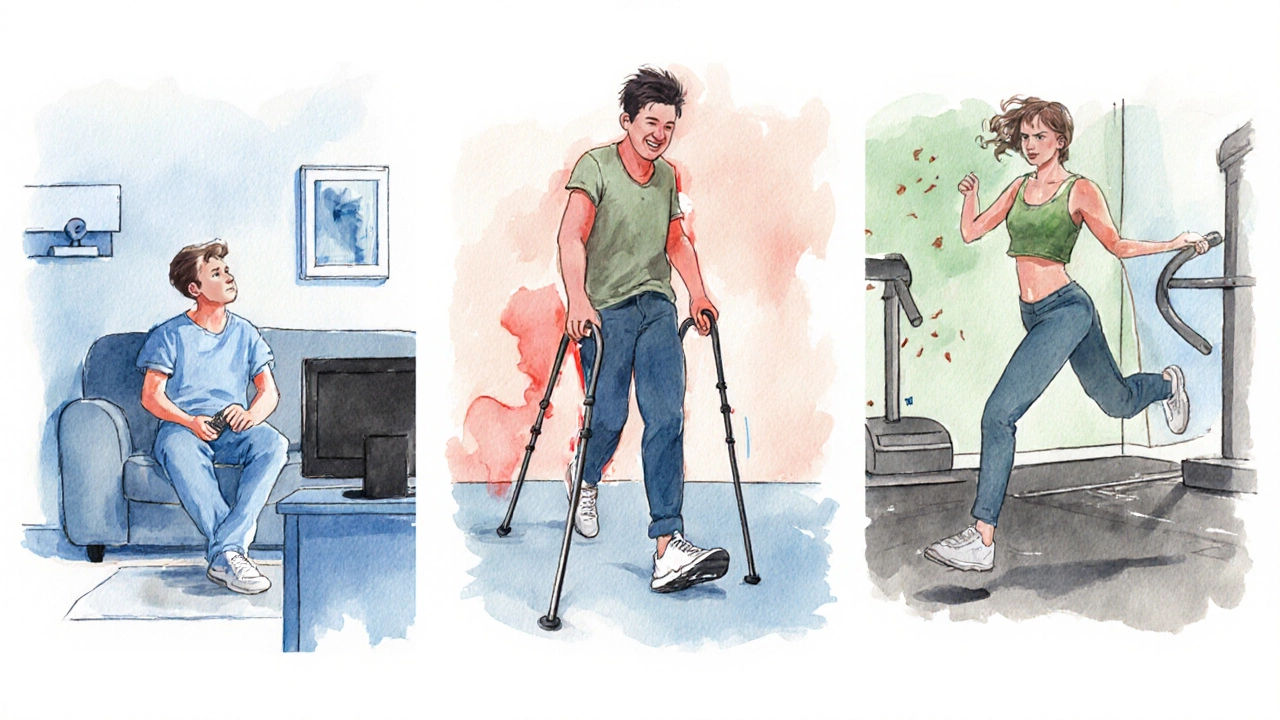Knee Surgery Recovery Timeline Calculator
Calculate Your Recovery Progress
When you undergo knee surgery is a medical procedure that repairs or replaces damaged structures in the knee joint, such as ligaments, cartilage, or bone. The excitement of getting back on your feet can quickly turn into frustration if you fall into common traps during recovery. Below you’ll find the most frequent missteps, why they happen, and practical ways to sidestep them so you can heal faster and stronger.
Key Takeaways
- Start gentle range‑of‑motion exercises within the first few days, but avoid aggressive stretching.
- Follow a graduated weight‑bearing schedule; too much pressure too soon can damage the surgical repair.
- Watch for swelling, pain spikes, or warmth - they may signal infection or a blood clot.
- Commit to regular physiotherapy sessions and home exercises; skipping them slows progress.
- Maintain a balanced diet rich in protein and vitamin C to support tissue healing.
Mistake #1: Ignoring the Rehab Plan
Many patients think “I’ll just rest and let my body heal.” In reality, a structured physiotherapy program is the backbone of a successful recovery. Skipping sessions or doing exercises incorrectly can lead to stiffness, reduced range of motion, and even re‑injury.
Enter physiotherapy a supervised program that includes strength, flexibility, and gait training tailored to post‑operative needs. Consistency is key - aim for at least three guided sessions per week in the early weeks, plus daily home drills.
Mistake #2: Rushing Weight‑Bearing
Putting full weight on the leg too early can stress the fresh sutures or implants. Most surgeons prescribe a graduated schedule: partial weight for 2-4 weeks, then full weight by week 6-8, depending on the procedure.
Use a mobility aid such as crutches, a walker, or a cane that helps control load on the healing knee exactly as instructed. If you feel sharp pain or instability, back off and contact your surgeon.
Mistake #3: Over‑doing the Exercises
Enthusiasm is great, but pushing beyond prescribed limits can cause swelling, pain, and even tissue damage. Follow the surgeon’s and therapist’s guidelines on reps and resistance. Avoid high‑impact activities like jogging or jumping until cleared - typically after 12-16 weeks.

Mistake #4: Neglecting Swelling Management
Swelling peeks in the first 48hours and can linger for weeks. Not using ice or compression can prolong inflammation and limit mobility.
Apply a cold compress an ice pack wrapped in a thin towel, applied for 15‑20 minutes, several times a day and keep the leg elevated above heart level whenever possible.
Mistake #5: Skipping Pain Medication or Taking Too Much
Under‑medicating leaves you guarding the knee, which slows movement. Over‑medicating can mask warning signs of complications.
Follow the prescribed pain medication typically a short course of NSAIDs or opioids, with clear dosage instructions. Use them as needed, but report any uncontrolled pain to your doctor.
Mistake #6: Ignoring Signs of Infection or Blood Clot
Redness, warmth, fever, or increasing pain may indicate infection. Unexplained calf swelling, tightness, or shortness of breath could signal a deep vein thrombosis (DVT).
Promptly contact your surgeon if you notice these symptoms. Early treatment prevents serious outcomes.
Mistake #7: Poor Nutrition
Healing tissue needs protein, vitamin C, zinc, and adequate calories. A diet lacking these slows collagen formation and bone remodeling.
Include lean meats, beans, leafy greens, citrus fruits, and nuts. Stay hydrated - water supports joint lubrication and waste removal.
Mistake #8: Missing Follow‑Up Appointments
Routine check‑ups let surgeons monitor healing, adjust rehab, and catch complications early. Skipping them can leave problems unnoticed. Schedule and attend every post‑op visit, typically at 2 weeks, 6 weeks, and 3 months.

Quick Reference Table
| Mistake | Recommended Action |
|---|---|
| Skipping physiotherapy | Attend all scheduled sessions and do home exercises daily |
| Weight‑bearing too early | Follow graduated load plan; use crutches as prescribed |
| Excessive exercise intensity | Stick to therapist‑approved reps and avoid high‑impact moves |
| Ignoring swelling | Ice regularly, elevate leg, wear compression if advised |
| Improper pain control | Take meds as directed; report uncontrolled pain |
| Overlooking infection/DVT signs | Monitor skin, temperature, calf size; seek medical help promptly |
| Bad diet | Eat protein‑rich foods, vitamin C sources, stay hydrated |
| Missing follow‑ups | Keep every appointment; note any new symptoms for the doctor |
Checklist Before You Leave the Hospital
- Confirm your rehabilitation timeline a week‑by‑week guide outlining weight‑bearing, exercise, and milestones with the surgeon.
- Get a written list of prescribed medication including dosage, frequency, and duration.
- Know when to start range of motion controlled bending and straightening exercises and how many repetitions.
- Arrange for a reliable mobility aid and understand how to use it safely.
- Schedule your first physiotherapy session (usually within 48hours).
When to Call Your Surgeon
Even with careful planning, complications can arise. Call immediately if you notice any of the following:
- Fever above 100.4°F (38°C) or chills
- Increasing redness, warmth, or drainage from the incision
- Sudden, severe calf pain, swelling, or a feeling of heaviness
- Persistent sharp pain that doesn’t improve with medication
- Inability to straighten or bend the knee as expected after a week
Pro Tips to Speed Up Recovery
- Set realistic goals - celebrate small wins like improving flexion by 10° each week.
- Use a foam roller to gently massage surrounding muscles and improve circulation after the first month.
- Incorporate low‑impact cardio (e.g., stationary bike) once cleared to boost blood flow.
- Practice deep breathing exercises to reduce swelling and improve oxygen delivery.
- Track your progress in a journal - note pain levels, swelling, and milestones.
Frequently Asked Questions
How soon can I start walking after knee surgery?
Most surgeons allow partial weight‑bearing with crutches within the first 2-3 days. Full walking without aid usually follows after 6-8 weeks, depending on the procedure and your comfort.
Is it normal to have swelling for several weeks?
Yes, mild swelling can last 4-6 weeks. Keep icing, elevating, and using compression. If swelling suddenly worsens or is accompanied by fever, call your doctor.
Can I take over‑the‑counter pain relievers with my prescription meds?
Often yes, but check with your surgeon. Some NSAIDs may interfere with blood thinners or affect bone healing, so verify dosage and timing.
When is it safe to return to the gym?
Typically after 3-4 months, once you have full range of motion, good strength, and your surgeon gives the green light. Start with low‑impact machines before moving to heavy lifting.
Should I do any special exercises to prevent scar tissue?
Gentle stretching and controlled range‑of‑motion drills, as prescribed by your physiotherapist, keep the tissue supple and reduce adhesions.
Recovering from knee surgery mistakes isn’t about luck - it’s about knowing the pitfalls and taking smart, steady steps forward. Follow the plan, listen to your body, and you’ll be back to your favorite activities sooner than you think.
